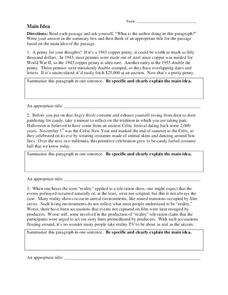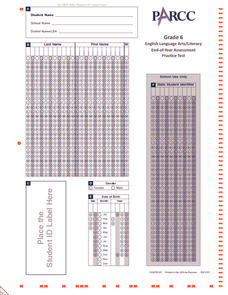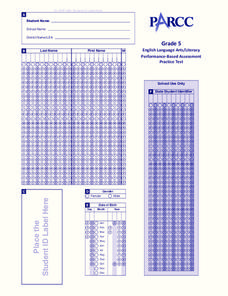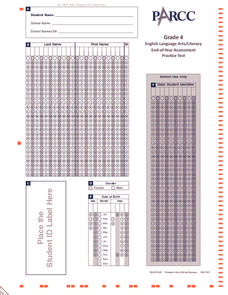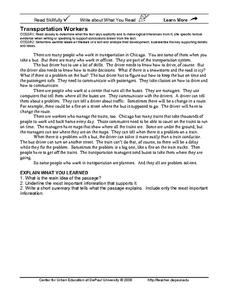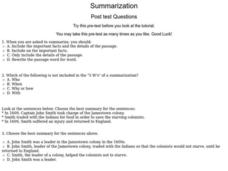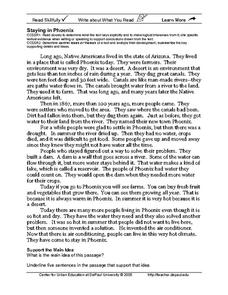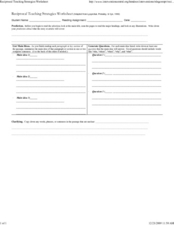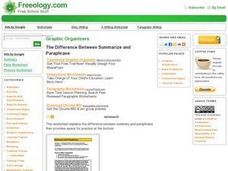E Reading Worksheets
Main Idea 2
Learners read short paragraphs, summarize the passage in one sentence, and then develop an appropriate title that indicates the main idea of the selection. Part of a series of exercises designed to build literary skills.
E Reading Worksheets
Main Idea
To develop their reading comprehension skills, learners read short paragraphs, summarize the passage in one sentence, and then develop an appropriate title that indicates the main idea of the selection.
Curated OER
Summarizing Worksheet
In this summarizing skills worksheet, students answer ten multiple choice questions based on the conceptual framework for writing a summary.
Curated OER
Reading Comprehension 2: Level 12
Ever heard of CTE? A passage about Chronic Traumatic Encephalopathy (CTE) provides the text for a reading comprehension check. The subject matter is sure to engage your readers and the questions, based on the passage, assess whether high...
Curated OER
Analyzing Poetry
Use this poetry analysis worksheet to help your learners understand a poem of their or your choosing. This resource asks class members to summarize the poem and analyze it by looking at voice, word choice, imagery, and theme. The...
Curated OER
End-of-Year Practice Test (Grade 6 ELA/Literacy)
With the end of the year quickly approaching it's time to find out exactly how much your sixth graders have learned. Specifically designed for the Common Core ELA standards, this practice test gives students five reading passages,...
Curated OER
Performance-Based Assessment Practice Test (Grade 5 ELA/Literacy)
Check in on the development of your fifth graders' reading and writing skills with this Common Core-designed assessment. Given a series of six reading passages ranging from narrative stories to informational texts, young...
Curated OER
End-of-Year Practice Test (Grade 4 ELA/Literacy)
The time has come to find out what your fourth grade readers have learned after another year of hard work. This Common Core-designed practice assessment provides two reading passages, one narrative and one expository, that children must...
Curated OER
Transportation Workers
Summarizing a text means being able to identify supporting details. Your class can learn about transportation workers in Chicago as they read a one-page informational passage. When they are finished reading they'll explain what they've...
Curated OER
Learning To Summarize
In this learning to summarize worksheet, students interactively answer 10 multiple choice questions about summarizing information from a given passage, then click to check their answers.
Curated OER
Staying in Phoenix
Read to learn! Here is a one-page informational passage about inhabitants of Phoenix, Arizona. Learners will read to make logical inferences and determine the central idea or theme. Prompts ask the class to identify the main idea and...
Fluence Learning
Writing an Opinion: Student Council
A three-part assessment challenges scholars to write opinion essays covering the topic of the student council. After reading three passages, writers complete a chart, work with peers to complete a mini-research project, answer...
Curated OER
Space Food
What do astronauts eat in outer space? Kids can read an informational passage to learn about space food. The passage includes prompts that have learners identify the main idea and key details, then write a paragraph summarizing the text....
Fluence Learning
Writing Informational Text: Lemonade Stand
Use a performance task to assess third graders' ability to read informational text. After they plan a lemonade stand business, young entrepreneurs implement that plan through informational writing. The task assumes learners can...
Curated OER
Synthesize, Don't Summarize
In this reading and writing analysis worksheet, students read two passages, one a summary of Flowers for Algernon and one a synthesis of the novel. The goal for students is to understand the effectiveness of synthesizing a piece of...
K12 Reader
Oliver Twist
Middle schoolers demonstrate their ability to summarize by crafting a summary of a passage from Charles Dickens' Oliver Twist. Oh that Dickens should be so laconic.
Curated OER
Reciprocal Teaching Strategies Worksheet
In this pre-reading activity worksheet, students respond to 3 questions that require them to list main ideas, generate questions, and clarify unclear items prior to reading a selection.
E Reading Worksheets
Main Idea Worksheet 5
Did you know that Marie Curie's papers, as well as her cookbook, are radioactive and stored in lead-lined boxes? Did you know that Nikola Tesla developed a death ray? Famous scientists and inventors are the subjects featured in a series...
Curated OER
The Adventures of Tom Sawyer: Finding the Main Idea
After reading chapter 17 of The Adventures of Tom Sawyer, give this graphic organizer to your kids to find the main idea. The circles are small and will probably spark complaints, but the main idea should never be lengthy; it should be...
Curated OER
Summary and Paraphrase
In this summary and paraphrase worksheet, students review the definition for a summary and paraphrase. Students learn the steps for writing a summary and then write one for the passage.
Curated OER
Today’s Telephone
Does your class know the history behind today's telephone? They will after reading a very interesting one-page informational passage. They'll learn all about the way phones have progressed to the amazing devices they've become as they...
Curated OER
Et tu Brute?: Fun Trivia Quiz
A unique format for a reading comprehension quiz, the questions for this test give a brief statement as if spoken by Marcus Brutus which asks readers questions about major characters and plot elements in Shakespeare's play Julius Caesar....
Curated OER
Discussion Director
In this discussion activity worksheet, students read the descriptions of several individual roles for book discussion groups. Students then complete specific activities based on the role they take.
Curated OER
Note-Taking to Summary Writing
In this note-taking worksheet, students review an example of notes for a paragraph and then the summary for those notes. Students then read a new passage, take notes over the passage, and then write a summary for the passage.

